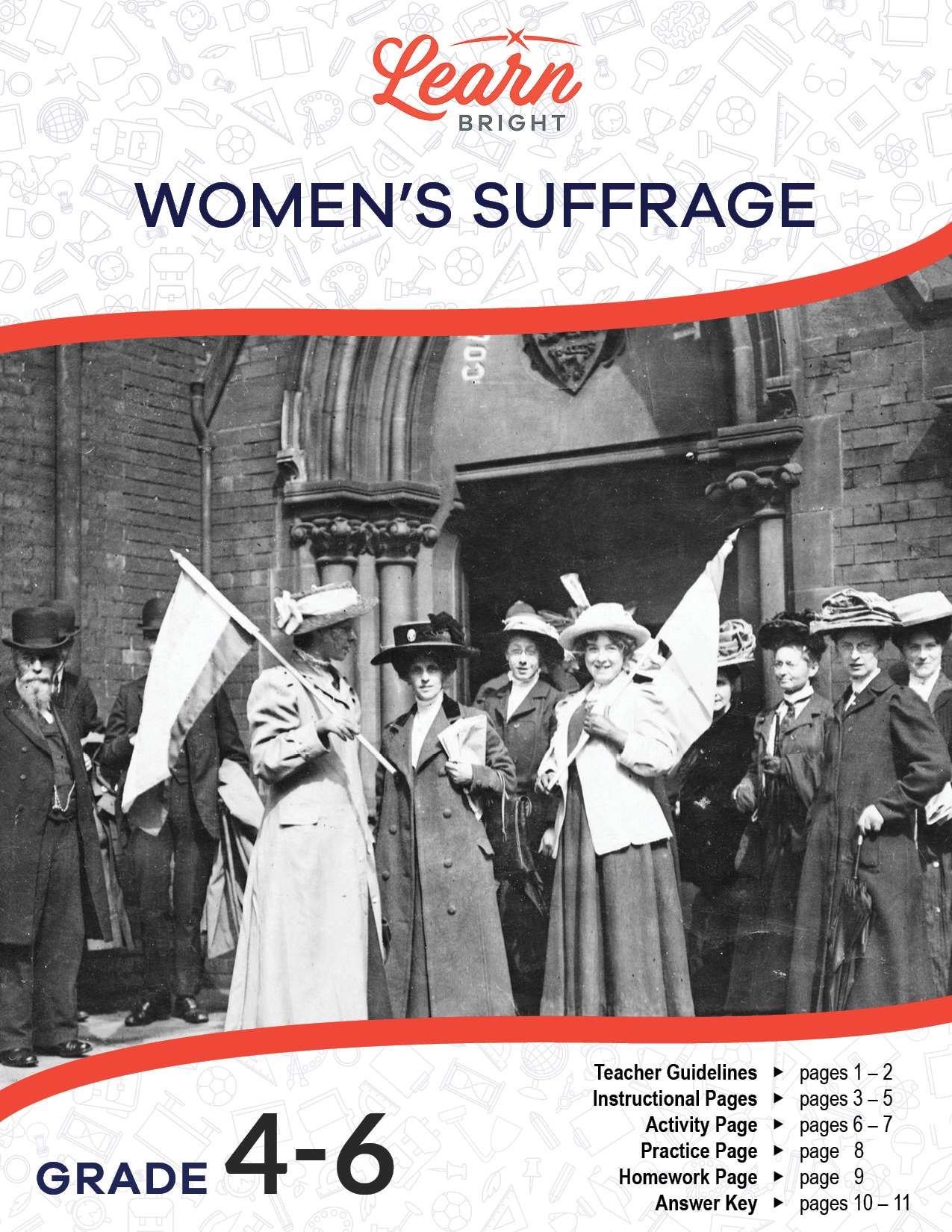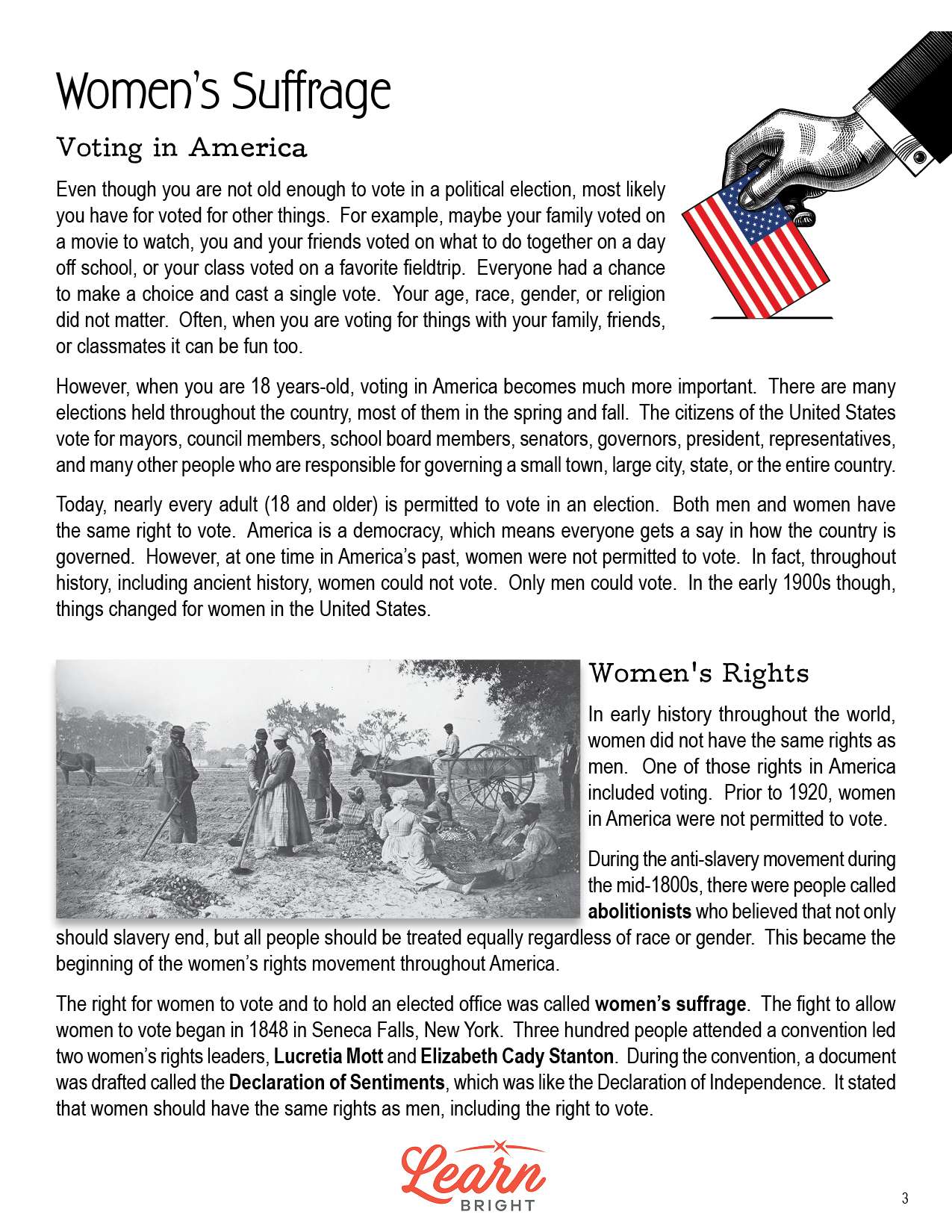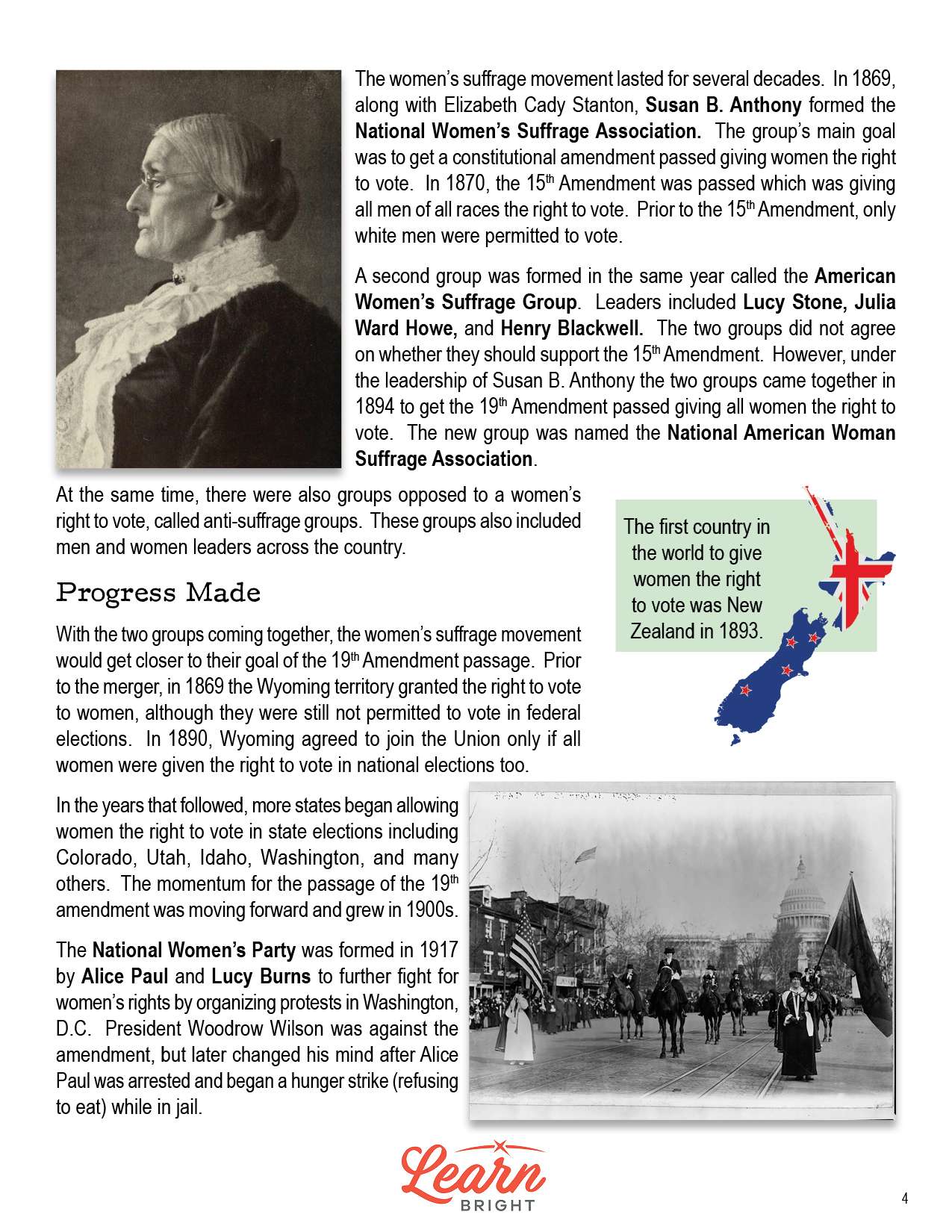Description
What our Women’s Suffrage lesson plan includes
Lesson Objectives and Overview: Women’s Suffrage lesson plan introduces students to women’s suffrage, the fight for women’s right to vote in the United States. Key leaders of the movement and important events are summarized, as well as an introduction to the 19th amendment. Most students are unaware that at one time in history, women were not permitted to vote, and had fewer rights than men. At the end of the lesson, students will be able to define women’s suffrage, describe women’s suffrage in America, and identify important events and people related to the voting rights movement. This lesson is for students in 4th grade, 5th grade, and 6th grade.
Classroom Procedure
Every lesson plan provides you with a classroom procedure page that outlines a step-by-step guide to follow. You do not have to follow the guide exactly. The guide helps you organize the lesson and details when to hand out worksheets. It also lists information in the orange box that you might find useful. You will find the lesson objectives, state standards, and number of class sessions the lesson should take to complete in this area. In addition, it describes the supplies you will need as well as what and how you need to prepare beforehand. The supplies you will need for this lesson are colored pencils, scissors, poster paper, scratch paper, markers, paint, ruler, and the handouts.
Options for Lesson
Included with this lesson is an “Options for Lesson” section that lists a number of suggestions for activities to add to the lesson or substitutions for the ones already in the lesson. An optional adjustment to the lesson activity is to split it into two parts and have students complete only the first part. You can have your students vote on the best poster design, best slogan, more creativity, and more. To add to the activity, you could plan a Women’s Suffrage Parade with students carrying their posters through the halls of the school or outdoors in front of the school and create a video of the parade. For an additional activity, you could allow students to give speeches about women’s right to vote. You could also assign each student a different women’s right’s leader to research and present to the class. You could plan a debate where one half of the class agrees with women voting and the other half disagrees. For another activity, you could assign each students a different country to research women’s voting rights. Finally, students can create a timeline based on events in the women’s rights movement.
Teacher Notes
The teacher notes page includes a paragraph with additional guidelines and things to think about as you begin to plan your lesson. This page also includes lines that you can use to add your own notes as you’re preparing for this lesson.
WOMEN’S SUFFRAGE LESSON PLAN CONTENT PAGES
Voting in America
The Women’s Suffrage lesson plan includes three pages of content. While students can’t vote in political elections because they aren’t old enough, it is possible that they’ve voted for other things, like which movie to watch on movie night. While voting, people usually have a chance to choose what they want and cast a vote for it, regardless of age, race, gender, or religion.
People 18 and over in the U.S. can vote in elections in the United States. Every year, many elections take place all over the United States, mostly in the spring and fall. People vote for mayors, council members, school board members, senators, governors, presidents, representatives, and more. Almost all adults age 18 and over can vote. Men and women can both vote. America is a democracy, which means that everyone gets a say in how people run the country. However, throughout history, women have not been allowed to vote. This did not change in the United States until the early 1900s.
Women’s Rights
Women did not have the same rights as men in early history and throughout the world. Voting was one of these rights. Before 1920, women were not allowed to vote.
In the mid-1800s, during the anti-slavery movement, people called abolitionists believed that everyone should have equal rights regardless of race or gender and that slavery should end. This is the origin of the women’s rights movement in the United States.
They called the movement for women’s right to vote women’s suffrage. Their fight began in Seneca Falls, New York in 1848. Two women’s rights leaders, Lucretia Mott and Elizabeth Cady Stanton, led a convention attended by three hundred people. During this convention they drafted the Declaration of Sentiments, a document that stated that women should have the same rights as men, including the right to vote.
This movement continued for several decades. Susan B. Anthony formed the National Women’s Suffrage Movement with Elizabeth Cady Stanton in 1869. They wanted to pass a constitutional amendment giving women the right to vote. Meanwhile, in 1870, the government passed the 15th Amendment which allowed all men to vote regardless of race. Before this, only white men could vote.
The same year, the American Women’s Suffrage Group formed, led by Lucy Stone, Julia Ward Howe, and Henry Blackwell. The two groups didn’t agree about supporting the 15th Amendment. The two groups came together in 1984 under Susan B. Anthony’s leadership to attempt to pass the 19th Amendment, allowing all women to vote. They called the new group the National American Woman Suffrage Association.
During this time, groups also formed to oppose the women’s suffrage movement. Both men and women joined these opposing groups.
Progress Made
Once the two groups came together, they came closer to passing the 19th Amendment by working together. Before they merged, in 1869, the Wyoming territory gave women the right to vote in state elections. In 1890, Wyoming agreed to join the Union only if women could vote in national elections.
More states, including Colorado, Utah, Idaho, and Washington, followed suit and started giving women the right to vote in state elections in the following years. This contributed momentum to the overarching movement.
In 1917, Alice Paul and Lucy Burns formed the National Women’s Party. they organized national protests in Washington, D.C. At first, President Woodrow Wilson opposed the amendment, but changed his mind after Alice Paul’s arrest and hunger strike.
The women’s suffrage movement lasted for many years and included many protests across the states. they blocked traffic and roads and the police arrested many women during the demonstrations. Many of these women participated in hunger strikes. The public sympathized with the movement more and more over time.
On August 20, 1920, 72 years after the convention at Seneca Falls, the 19th Amendment finally became law. Today, nearly every country allows women to vote.
WOMEN’S SUFFRAGE LESSON PLAN WORKSHEETS
The Women’s Suffrage lesson plan includes three worksheets: an activity worksheet, a practice worksheet, and a homework assignment. You can refer to the guide on the classroom procedure page to determine when to hand out each worksheet.
POSTER ACTIVITY WORKSHEET
Students will work with a partner to complete the lesson activity. Each pair will complete two activities. First, they will think of two new women’s suffrage movement slogans and will create posters with each slogan. Next, they will work together to write a persuasive letter to Woodrow Wilson asking him to approve the 19th Amendment.
WOMEN’S RIGHTS LEADERS PRACTICE WORKSHEET
The practice worksheet asks students to fill in the last name of each women’s rights leader using the word bank. They will then match the names to facts about each woman. Finally, they will answer five questions about the lesson content.
WOMEN’S SUFFRAGE HOMEWORK ASSIGNMENT
For the homework assignment, students will first tell whether 15 statements related to the lesson material are true or false. They will then answer a few questions about the lesson.
Worksheet Answer Keys
This lesson plan includes answer keys for the practice worksheet and the homework assignment. If you choose to administer the lesson pages to your students via PDF, you will need to save a new file that omits these pages. Otherwise, you can simply print out the applicable pages and keep these as reference for yourself when grading assignments.









